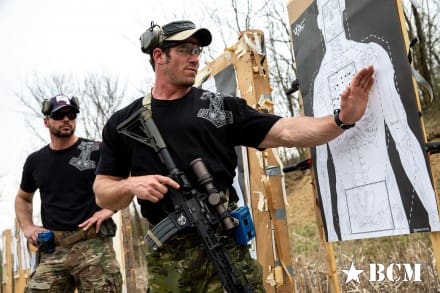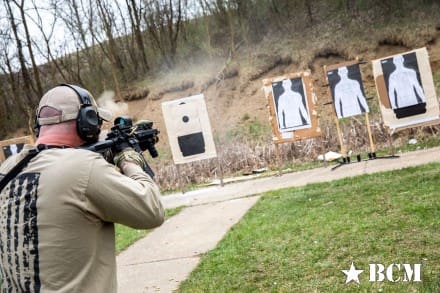To get the most out of training, it’s important to understand the purpose and intent behind drills. A drill can be defined as the repetitive practice of a skill, or a set of skills, in order to become increasingly proficient in the targeted action, while becoming more knowledgeable in the purpose of its implementation. All drills should be purposeful and relevant to what the end user is attempting to achieve. From a shooting perspective, it’s critical that we understand the “why” behind the drills we use on the range.
Let’s take a look at the “Target Transition” drill for pistol. We set this up with three IPSC or VTAC targets spread out one meter apart. The shooter is 8-10yds away facing the target line. Starting positions is pistol holstered and both hands above the shoulders. On command, the shooter will draw and shoot two shots on each target, attempting to place all rounds to the A-Zone in the body. This is a great example of a drill that works multiple skills. The draw, controlled pairs, recoil management, proper trigger reset, leading with the eyes to the next target, and driving the gun in recoil are the applied skills for this course of fire. The primary concept to comprehend is that most of these skills should be isolated and trained prior to running a drill such as this. The new or previously untrained skills for this drill should be leading with your eyes to the next target and driving the gun to a new location in recoil. For the shooter to get the most value out of this drill, they should have a thorough understanding, and a solid foundation of the other skills required. If the shooter has a weak or inconsistent draw and does not understand the concept of resetting the trigger in recoil, they will not be focused on the “new” skills that target transitions provide. We build up to complex drills such as this, ensuring the baseline is established for each individual skill before adding more to the plate.
Target Transitions is one of Northern Red’s favorite combat marksmanship drills. As previously discussed, it works a large spectrum of shooting skills. Putting all of these skills together consistently will drastically improve a shooter’s weapons handling. But more important than the skills it trains, is the realistic transfer of those skills to a combat situation. This is the “why” behind it. Some may say that this drill is primarily training the shooter to deal with multiple threats. We agree that is one reason why target transitions are important, but we believe there is a greater and more plausible purpose. Humans will move when engaged with firearms. This happens to be the most predictably thing encountered during a gunfight. The main reasons, in our opinion, to become proficient on this drill is to practice shooting a moving target and training our eyes to move and see faster. These skills directly correlate to all engagements, and should be trained consistently. The likelihood of needing these skills in a real-world situation is high. That, fundamentally, is the main reason this drill is so important to understand and master.
If you find yourself struggling on a certain shooting skill, we suggest you break the skill down and run drills that specifically target that area. A perfect example is someone who has trouble consistently finding their sights on the draw. If the proper mechanics of coming down to the gun and clearing the holster are not the issue, then isolate the problem area. In this example, the shooter should work on the presentation from the ready position, which is the second half of the draw-stroke. Rep that out until you are finding your sights in the same spot consistently and watch what it does for your draw.
Training should be fun. If you are not enjoying it, you’re less likely to continue putting in the time and effort to get better. We are not saying run boring drills, we are suggesting utilizing the drills you or your unit needs. Make sure they are targeting specific skills that are relevant to your job, or emulate situations you may encounter. As always, never shy away from your weaknesses, especially if you are deficient in a skill needed to perform your duties. Additionally, make sure you, your teammates, or your students understand the “why.” This final point is vital for information retention and application of the skill on game day.
Gunfighter Moment is a feature brought to you by Bravo Company USA. Bravo Company is home of the Gunfighters, and they bring us a different trainer to offer some words of wisdom.
Tags: BCM, Bravo Company, Gunfighter Moment, Northern Red



